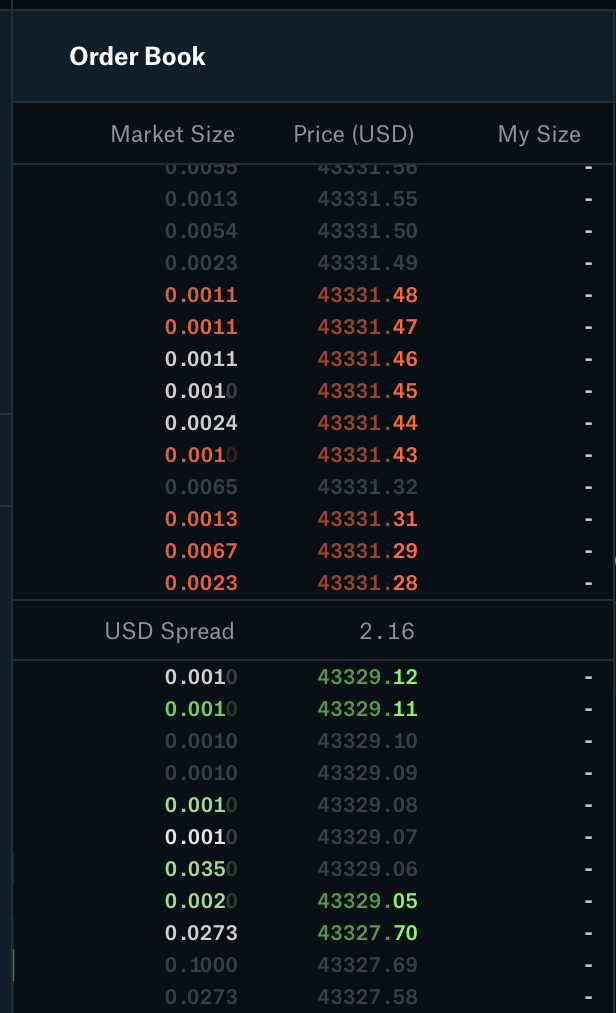Market spread in crypto: Essential guide

Subtle details make a big difference in cryptocurrency trading. While investors in conventional markets can delegate to brokers or fund managers, crypto trades are usually direct. Keeping track of price movements is only part of the challenge. In this guide, we will explain the market spread, one of the first considerations for a savvy trader.
Crypto marketplace: Basics
If you have no experience using a crypto exchange, the first thing to learn about is the exchange order book. This is a list of all orders that are currently open for a particular trading pair. In layman’s terms, it shows offers from investors who are willing to buy or sell this asset at a particular price.
All assets are traded in pairs as they are valued against one another. Any pair follows this pattern:
Base currency (ticker symbol)/Quote currency (ticker symbol)
Prices listed for BTC/USD, ETH/USD, or LTC/USD show how much users are willing to pay or get in US dollars when buying or selling the base crypto. For example, a $60,000 buy order for BTC/USD means the user wants to purchase bitcoins for 60,000 US dollars each. Exchanges feature a plethora of pairs, both crypto-to-crypto (for example, LTC/USDT and BCH/BTC) and crypto-to-fiat (for example, POL/AUD and DOT/GBP).
Big cryptocurrency platforms list hundreds of open orders. Any user with an exchange account can place one. It will remain on the order book until accepted by someone else or canceled by the user.

What is crypto market spread?
Whatever the asset, any exchange transaction involves two prices — one offered by the seller (Ask) and one offered by the buyer (Bid). The gap between them on the order book constitutes the market spread. This term is also used in other markets, including foreign exchange, CFD trading, and spread betting — a leveraged derivative strategy used in the UK.
Suppose you want to buy one bitcoin from someone else. You offer to pay them $70,000, which you think is a fair price. If your counterparty refuses to sell for less than $72,000, there is a $2,000 gap between your offers.
On a cryptocurrency exchange, this works a bit differently. Order books are packed with offers from buyers and sellers — one platform may feature hundreds of them. The market spread is formed by two extremes:
- lowest asking price (applied to a short position)
- highest bid price (applied to a long position)
How to calculate crypto market spread
As you can see from the image below, the spread is the difference between the bottom red and top green (that is, lowest sell price and highest buy price) for one asset at any given moment. It is constantly changing, following the price movements. The market spread is easy to find and even calculate manually.

All you need to do is deduct the highest bid for your crypto ($43,329.12) from the lowest ask price ($43,331.28). Hence, the universal formula is
Lowest ask - highest bid = market spread
In our example, this calculation gives us $2.16 ($43,331.28-$43,329.12). This is a raw value. You can also calculate the spread percentage to see how liquid the market is. To turn a decimal value into a percentage, we will multiply the result by 100:
Percent spread = (spread/lowest ask) x 100
When applied to our example with BTC/USD, this calculation gives:
($2.16/$43,331.28) x 100 = roughly 0.005%
The same calculation works for pairs without USD. Cryptocurrency exchanges determine the spread for every asset automatically. It is explicit — often, this indicator visually divides the lowest price set by sellers from the highest price set by buyers in the order book.
How does market spread influence crypto trading strategy?
The price gap is one of the core factors for the performance of any trading strategy. Contrary to a common misconception, it matters more than the trading fee. The market spread has the power to sway your profitability more strongly than the cost per trade.
Those who trade frequently must consider the effects of the spread to ensure positive results. Sadly, not all backtesting environments incorporate the market spread in simulated trades. This inaccuracy results in a chasm between the test outcomes and reality.
The following example shows how wide the spread could get. Suppose the highest bid offer for BTC is $70,000, and the lowest ask offer is $71,600. In this situation, the raw spread is $1,600 ($71,600-$70,000), and the percent spread is 2.23% ($1,600/$71,600 x 100).
The bigger the spread, the more a trader can lose, even if the asset gains value afterward, pushing the sell price up. The reason is that users always want to pay as little as possible, but sell at the highest bid level. Tight spreads indicate high market liquidity, which means that buyers and sellers of digital currency have no problem connecting.
Here is an example of an extraordinary gigantic spread on Coinbase on May 13, 2021. If you were to buy and immediately sell Bitcoin at that moment, you would have made a loss of $260. This is not the most extreme situation, as users have seen spreads reach and exceed $800.

In the situation above, if you wanted to buy Bitcoin, you would have to pay at least $8,000, as this is the lowest ask price. Next, you would have to wait for the best bid price (including trade fees) to surpass $8,000. Otherwise, you wouldn’t make any profit selling the coin.
Now, suppose the price of Bitcoin jumped by $300. This still would not justify new trades, as you would get $7,800 selling BTC previously bought for $8,000.
So, what does a tight spread look like? Consider this situation (ignoring the trading fees).
The highest bid price for BTC is $70,500.
The lowest ask price for BTC is $70,510.
The raw spread is $10 ($70,510.00-$70,500).
The percent spread is 0.014% ($10/$70,510 x 100).
In this scenario, you wouldn’t have to wait long for the bid price to work in your favor. Once it rises past $10, you can turn a profit by selling your BTC.
Now you know what spread means in cryptocurrency trading and why it matters. Whether you buy bitcoin or trade complex instruments like derivatives, the same logic holds. Wider spreads indicate less liquidity and higher risk. Let’s recap the key points.
Key takeaways
Market spread is the difference between the lowest asking price and the highest bid price of the same asset.
The smaller it is, the better for a trader who wants to open a long position (that is, buy and subsequently sell the instrument).
Assets with small spreads are easier to profit from.
Assets with larger spreads must perform better to allow sellers to profit. If you sell too early, you risk losing money rapidly.
It is now easy to see why a large bid ask spread can eat into your profits. The difference between buy and sell prices is one of the primary market indicators. Going back and forth when the gap is large will backfire. Be patient and keep an eye on it if you want to succeed in cryptocurrency trading.
Spread matters for both direct and indirect forms of trading. In the UK, instead of buying and selling crypto assets directly, users can profit from spread bets. These derivatives are similar to CFDs (contracts for difference), as no actual crypto is bought or sold.
A trader placing spread bets merely speculates on whether the price will rise or fall. The main difference is in taxation. Additionally, unlike CFD trading, spread betting is prohibited in the United States.



